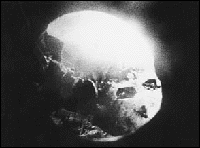|
|
|
監督・撮影・編集・録音・出演・製作:大西健児
Director, Script, Photography, Editing, |
1973年4月13日生。1990年より8mm映画カメラを回し始め、映画製作を開始する。短編の映像作品も数えると優に100タイトル以上をこの7年間に製作。近年は長編16mm映画を中心に『スクエアワールド』(1995)、『水槽都市』(1996)など、国際的にも注視を集める問題的な尖鋭映画を立て続けに発表。他に比較すべき存在のない、独自のスタンスによるグローバルな活動で知られる。現在、初の劇場公開用長編劇映画『蟻の農場』の準備中。 Born in 1973. Began making 8mm films in 1990 and has made over 100 films including short works. Recently has focused on longer 16mm films such as Squareworld ( " Sukueawaarudo, " 1995) and continues to direct problematic and radical films like Aquarium City ( " Suiso toshi, " 1996) that have attracted international attention. Onishi is unique in his filmmaking style and is known for his personal stance and global activities. At present he is preparing his first feature film for theatrical release Ant Farm ( " Ari no nojo " ). |
 |
|
| 日本の若手作家による『焼星』は、物体的な「崩壊」と「消滅」を、父親の死と葬儀を通して徹底的に追及した作品。映画にとって「見ること」「撮ること」の重要性を、独自のテンポと息の長さに乗って考えさせられる。 | A Burning Star depicts the physicality of destruction and disappearance through images of the Japanese filmmaker's father who dies and is cremated. Maintaining a solid rhythm and perspective, this film highlights the meaning and importance of " viewing " and " filming " in documentary. |
|
|
|
|
監督のことば 私は、表現する事の絶対的な手段としてカメラの重要性を第一に考える。それはヴェルトフの唱えた〈映画眼〉の重要性を、私流に解読し、改定した大西流〈映画眼〉の実践だろう。『焼星』は私の内面的葛藤が残酷な形で実体化された作品だ。“父の死”と言う目前の問題との決着に、私はカメラを通して答を出す結果となった。ヒトであるから動揺するし、たじろぎもする、悲しみもすれば、恐れもする。しかし、作り手である時点で私はそれらを抹殺できる。これは、映画作家に与えられた唯一の力だと考えている。カメラはそれに形を与える道具にすぎなかった。そして、私には“死”にカメラを向けることに対して、人道的な大義名分も、手法的な構成も、何等の逃げ道を用意する必要がなかった。カメラが“死”という問題に対峙しえた『焼星』は、撮影行為だけで私と彼の距離を確実に記録した。それは原始的なまでに単純で絶対的な、映画の、そして、私自身の可能性だ。 |
Director's Statement I think the camera is the most important aspect of the absolute process of expression. I ' ve interpreted Vertov's " camera eye " in a personal way adopting an Onishi style camera eye. In A Burning Star ( " Shosei " ) my inner conflicts find a cruel form. Through the camera I come to terms with my father's death. It's only natural that a person should tremble, hesitate, feel sad and be afraid. As the director, I can erase all of that. That's the unique power of the author. The camera is merely a tool to give it a form. When I turned the camera to the subject of death I felt no need to prepare humane justifications, a methodological structure nor escape routes. In A Burning Star the camera confronts the problem of death. Through the act of filming I recorded the distance between my father and myself. It is a primitive, simple and absolute film. In short, it is the possibility of my own self. |
